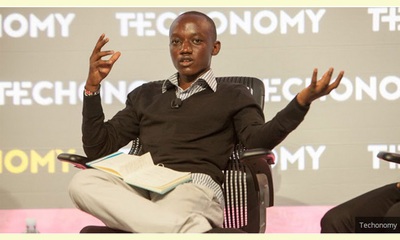|
|
A Kenyan kid turns his friends’ poop into clean energy
an article by Sam Bliss, Grist
In January 2013, Maseno School in western Kenya
had just completed a brand new dormitory, but
the building’s shoddy sanitation system was a
stinky mess. Founded in 1906 by Christian
missionaries, Maseno is the oldest English-
language school in Kenya and counts President
Obama’s pops among its notable alumni. The new
dorm, home to 720 students, featured a pit latrine
and malfunctioning sewer system that,
predictably, smelled like shit. Periodic blockages
brought on by lack of water made the foul odors
even more putrid, and the faulty sewer system
contaminated a nearby stream that provided
freshwater to the community. 
Leroy Mwasaru. Photo by Techonomy
click on photo to enlarge
Meanwhile, using firewood for cooking fuel was
causing more problems. Burning wood in the
school’s kitchen poses a serious health risk,
threatening the lungs and throats of those who
prepare food. And cutting down trees for firewood
fuel provokes conflicts between the school and
the surrounding community as the forest is
depleted. Polluting the local water supply
aggravated these rifts, to the point that locals
protested the completion of the dormitory.
Leroy Mwasaru and four fellow students had an
idea to address the issues caused by inferior
sewage systems and wood-fired cooking at once.
Mwasaru, now 17, in his last year of high school,
explains: “Through a group of five, I initiated the
idea that … if we harvested this waste from the
720 students and also used the organic waste that
comes from the kitchen, slashing grass, and cow
dung, we can come up with a viable solution.”
Enter Mwasaru’s proposal for a human waste
bioreactor, or HWB, which produces biogas for
cooking from these so-called wastes. An
underground chamber holds the human, animal,
and kitchen excrement, while microorganisms go
to work breaking down the muck. This process
releases biogas, a source of renewable energy
comprised mostly of methane, the same as the
fossil fuel natural gas that powers most non-
electric stoves in the U.S. The gas is contained in
the HWB, ready for use as fuel.
This poo- and refuse-derived cooking fuel
replaces firewood in the kitchen, improving the
health of cooks, forest ecosystems, and
community relations. Burning biogas is good for
climate health too: It offsets the need for fossil
fuels and prevents the methane produced by
organic stuff decomposing from escaping into the
atmosphere to trap heat.
Mwasaru has relentlessly pushed to bring the
HWB to life. Soon after the new dorm had opened,
he and his biogas buds entered the inaugural
Innovate Kenya challenge, put on by Global
Minimum, a nonprofit organization that helps
teenagers in Kenya, South Africa, and Sierra
Leone develop creative projects to address social
problems in their communities. Their HWB project
was selected as a winner, which meant Mwasaru
and company got to attend the first Innovate
Kenya camp this past June. There, they designed
a prototype with help from MIT students and
lecturers.
(This article is continued in the discussionboard)
|








|
DISCUSSION
There is no question yet associated with this article.
* * * * *
LATEST READER COMMENT:
(The following is continued from the main article listed above.)
At a second Innovate Kenya camp, in September, the Maseno team presented the working prototype and successfully raised enough money to purchase a plastic digester — the big container that holds wastes as they’re breaking down to produce biogas — for their next demonstration. The gadget enables the group’s second prototype to pump biogas directly into the school’s kitchen.
Today, HWB No. 2 is up and running. Mwasaru says they feed this prototype organic waste from the school farm as well as food remains from the staff and students. The kitchen cooks with the biogas, though not exclusively, since the plastic digester produces only small volumes.
Earlier this month, Mwasaru got to present at the Techonomy 2014 conference in Half Moon Bay, Calif., participating in a panel discussion on how his generation is rethinking innovation in Africa (check out the video). Innovate Kenya chose him from 32 finalists to make the trip. It was his first time on an airplane.
Mwasaru relished the opportunity to share his idea while also learning from the creations and experiences of other conference-goers. He networked with Microsoft engineers and moguls like LinkedIn founder Jeff Weiner, finding new confidence and inspiration with each encounter.
Relentlessly focused on improving the HWB, Techonomy even provided Mwasaru a new techie idea to bring back to Kenya: biohacking, which means combining biological science with the hacker ethic of using free information to improve processes. . ...more.

|
|









